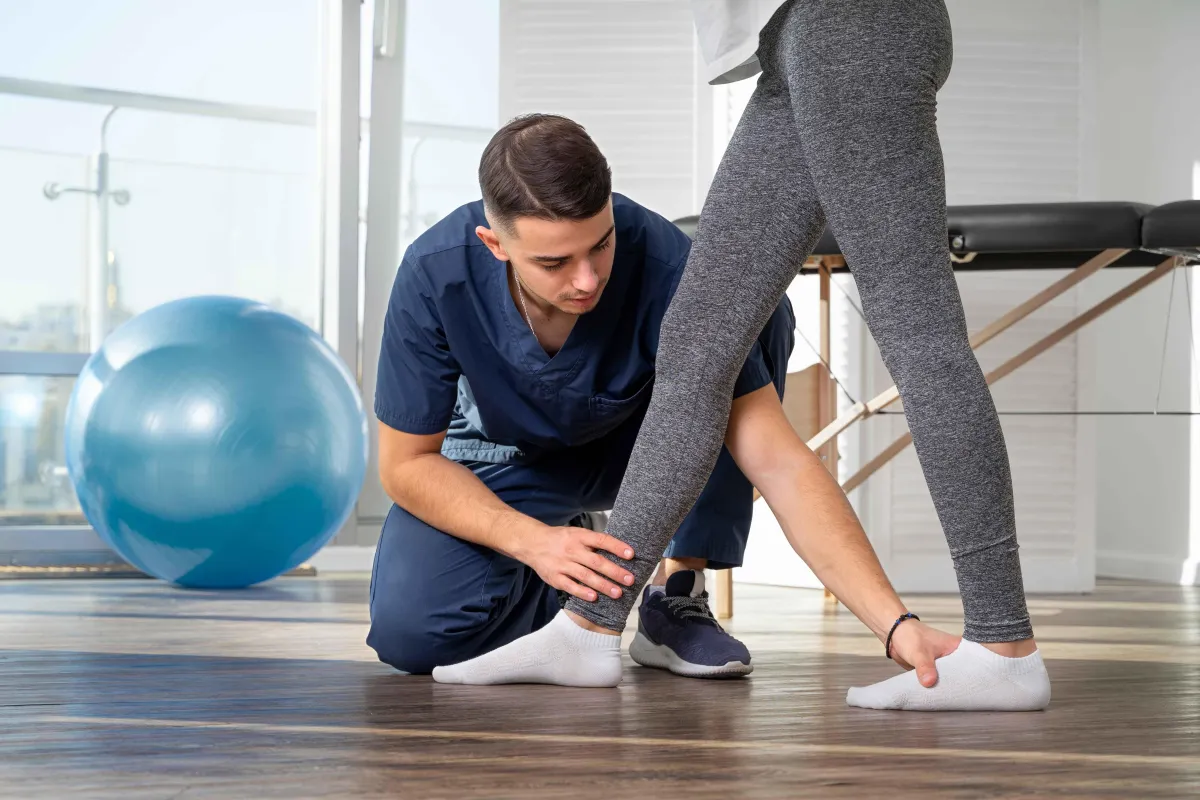Physical Therapy for Heel Spurs in NYC
Manhattan Physical Therapy

What Is Heel Pain?
Heel pain is one of the most common foot issues we see at Manhattan Physical Therapy, and it can affect anyone — from active runners to people who spend long hours standing. Because your feet absorb constant pressure and impact throughout the day, it’s not surprising that the heel can become irritated or injured over time.
In many cases, heel pain develops gradually, making it easy to overlook in the beginning. Patients often continue their normal activities without adequate rest, which can lead to worsening pain and even chronic discomfort. Depending on where the pain occurs, heel pain is generally classified into two main categories — beneath the heel and behind the heel.
Pain beneath the heel often results from plantar fasciitis or a heel spur, though bruising or overuse can also contribute. Pain behind the heel, on the other hand, is commonly caused by inflammation of the Achilles tendon. While mild heel pain may improve with rest, persistent or worsening symptoms often require professional evaluation and treatment to prevent long-term complications.
Two Types of Heel Spurs
Heel spurs are bony growths (osteophytes) that develop along the heel bone — medically known as the calcaneus. These growths typically form as a response to chronic stress, inflammation, or small tears in the surrounding soft tissue. The body creates extra bone tissue in an attempt to heal, but this can lead to a noticeable protrusion and discomfort over time.
There are two main types of heel spurs depending on where they form:
Plantar (bottom) heel spurs: These develop underneath the heel, where the plantar fascia attaches to the heel bone. This is often referred to as heel spur syndrome and is commonly associated with plantar fasciitis.
Posterior (back) heel spurs: These form at the back of the heel where the Achilles tendon inserts into the bone. This condition is often linked to insertional Achilles tendonitis and may cause pain when wearing tight shoes or engaging in activities that strain the Achilles tendon.
Heel spurs are more common among adults over 60, but they can also affect younger individuals who engage in repetitive high-impact activities or have biomechanical issues such as flat feet. Risk factors include:
Repeated stretching of the plantar fascia
Long-distance running on hard surfaces
Poorly cushioned or ill-fitting footwear
Excess body weight or obesity
Genetic predisposition to bone growth disorders
What Are the Symptoms of Heel Pain?
Heel pain can feel different for everyone because it’s linked to several possible causes. For some, the pain may be sharp and stabbing, especially when taking the first steps in the morning. For others, it may be a dull, aching discomfort that worsens throughout the day.
Common symptoms include:
Pain in or around the heel
Swelling and inflammation
Redness or warmth in the affected area
Tenderness when pressing on the heel
Difficulty walking or standing for long periods
What Causes Heel Pain?
Heel pain can have many underlying causes, and identifying the specific source is essential for effective treatment. At Manhattan Physical Therapy, we often see patients who experience heel pain due to repetitive stress, improper footwear, or biomechanical imbalances in the feet and legs. While mild cases may result from overuse or temporary irritation, ongoing heel pain is often linked to an underlying condition that needs professional attention.
The most common cause of pain beneath the heel is plantar fasciitis, which occurs when the thick band of tissue (the plantar fascia) connecting the heel bone to the toes becomes inflamed or overstretched. This typically leads to a sharp, stabbing pain in the heel, especially with the first steps after waking up.
Pain behind the heel is more often associated with Achilles tendonitis, an inflammation of the tendon that connects the calf muscles to the heel bone. This condition is particularly common among runners or individuals who suddenly increase their activity levels without adequate stretching or recovery.
Other potential causes of heel pain include:
Bursitis
Arthritis
Heel spurs
Tarsal tunnel syndrome
Bruising
Find Relief from Heel Pain in NYC
If heel pain is interfering with your daily life, don’t wait for it to worsen. The expert team at Manhattan Physical Therapy can help identify the underlying cause and develop a tailored treatment plan to relieve your discomfort and restore your mobility.
Our therapists use evidence-based methods, including manual therapy, targeted exercises, and gait correction techniques, to ensure long-term results. Call (212)-213-3480 to book your heel pain evaluation at Manhattan Physical Therapy.
What others are saying
Alexander Liu
"Everyone on the team at Manhattan Physical Therapy is super nice and caring. They were able to pretty quickly diagnose my knee and hip problems and immediately put me to work to reduce the pain.."
Henry Myerberg
"You're not just a patient when you come to the Manhattan Physical Therapy. You feel like family there. In particular, Erica with her colleagues John, Lidia and Joe not only fix and improve you physically, they make you feel welcomed and cared for.."
Hakyung Kim
"Everyone is so kind and helpful! my knee and hip pain have improved massively since starting Manhattan PT, highly recommend to anyone. special thanks to Bianca, Lidia, Joe, and John!"
Manhattan Physical Therapy
✆ Phone (appointments):
(212) 213-3480
Address: 385 5th Ave, Suite 503, New York, NY 10016

